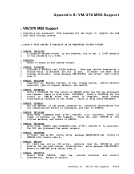r
DMKDIRED
terminal as a dedicated device to an existing
virtual
addressed by the command line.
that has not yet been activated through either
the console function DIAL for
console function
Initial program loaded or run under
Builds a user directory on a system owned volume
using pre-allocated cylinders.
End of load
floating-point registers, general registers, and
clocks to a specified device.
Initial program loads the system over again.
Delete system
Manipulates input spool files via a
Reads a
Reads the
Collects
Resident.
Entered after each interruption handler is
finished processing and after each stacked
has been serviced. It updates the
updates all virtual
pending interruptions for which the user is
enabled. After the user's status has been
updated, the highest-priority runnable user is
dispatched.
Immediate redispatch path for virtual
timers.








































































































































































































































































































































































































































































